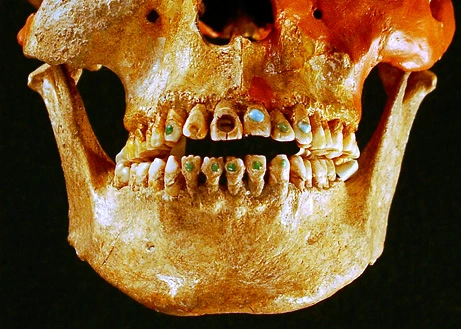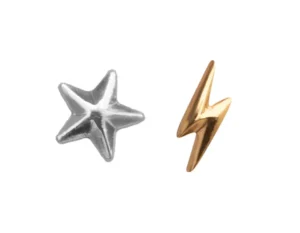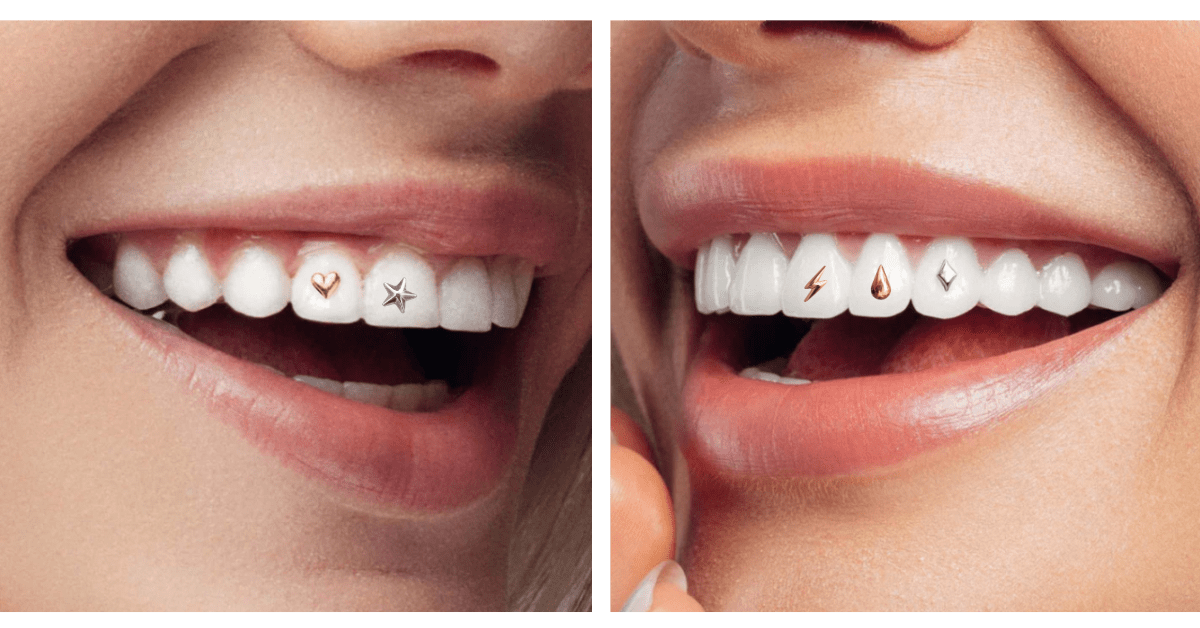Along with many fashion trends from the 90s, gold tooth gem charms are having a resurgence. While celebrities have always influenced what’s in style, the crazes of today are even further amplified by social media platforms like TikTok and Instagram. The tooth gem trend is particularly interesting, as it highlights an intersection between dentistry and fashion. But what do dentists really think about tooth gems – do they put your oral health at risk? How long does gold tooth jewelry last, and how much does it cost? Let’s find out.
History of Tooth Jewelry
Tooth décor is nothing new. In fact, archaeological evidence suggests that people have been bedazzling their teeth for thousands of years. Dental decoration has been practiced throughout history in many shapes and forms, for a variety of reasons.

Historians believe that some of the first humans to decorate their smiles were the Mayans, who used jade, gold, turquoise, and other stones like hematite. They drilled holes into their teeth and used and materials like plant sap to bond different embellishments. This was often seen as a rite of passage into adulthood.
The Etruscans of ancient Italy practiced dental decoration as early as the 6th century BCE, using gold bands or wire to attach artificial teeth or to replace missing teeth. The ancient Egyptians also used gold wire and semi-precious stones to decorate their teeth. These are just a few examples of civilizations that modified their teeth for aesthetic reasons. Tooth embellishment throughout different time periods has often been associated with wealth and status, carrying social and/or religious significance.
The Application Process
Most of today’s tooth jewelry is applied with a special dental adhesive. First the tooth cleaned and dried. The tooth’s surface is then textured with an acidic etching gel to help the adhesive bond to the enamel. Next, dental adhesive is applied to the tooth. The gem is then placed and positioned carefully, and finally cured with a dental curing lamp. The whole process takes about 20 minutes and should be painless as long as the tooth is healthy. If the tooth being embellished has worn enamel, there could be some sensitivity.
Although a DIY approach has been documented on popular apps like TikTok, applying tooth gems yourself is never a good idea. The bonding materials that are often used in DIY kits such as super glue or nail glue are not designed for oral cavities and are unsafe for oral use. Dental jewelry of any kind should be applied by a professional to avoid complications like cavities, tooth damage and even decay. Proper placement of tooth gems is vital, and professionals know how to place the gems strategically to avoid soft tissue damage and lip ulcerations.

How Long Do Tooth Gems Last?
With proper care, semi-permanent tooth gems are designed to last anywhere from six months to a year or more. The quality of the adhesive material used and the patient’s oral hygiene habits will ultimately determine how long a tooth gem lasts. Proper aftercare will help you get the most out of your dental jewelry.
The quality of the jewelry itself will also impact longevity. Diamonds, Swarovski crystals and gold are known for their resilience. Gold in particular is both aesthetically pleasing and resistant to corrosion!
How Much Are Tooth Gems?
Tooth gems can vary widely in cost, ranging from $30 to $100+ for precious metals and high-quality crystals. Twinkles Dental Jewelry is a popular brand that offers 18k, 22k and 24k gold tooth gem charms ranging from $26 to $88. We’ve also seen sets of 18k gold tooth charms on Etsy for around $30.
However, the cost of the tooth gem itself does not include the fee that a professional will charge to apply it to your tooth, which can range anywhere from $50-$300 per gem.
If you have extra gold tooth gem charms that you’re no longer wearing, they may be worth something. Rather than disposing of leftover gold dental jewelry, you could always ship it to a precious metals refinery like Garfield to recycle and monetize your scrap!
Is Dental Jewelry Safe?
While there’s a spectrum of opinions on this topic, dentists generally seem to agree that tooth gems are not great for your enamel. Risks that come with dental jewelry include enamel damage, plaque buildup and decay. The area underneath a tooth gem cannot be properly cleaned until it’s removed, which often means a year or more of compromised oral care. Make sure to do your research, choose high-quality materials, and have a dental professional apply your tooth jewelry.
Roots, Risks and Resale Options
The gold tooth charm trend has a rich cultural history and ancient roots. While dental jewelry application is generally safe and painless when performed by a professional, there are always risks involved, as with any type of body modification. Tooth gems should always be applied and removed by a professional.
Along with diamonds and crystals, gold is a popular choice for tooth gems, offering biocompatibility and resistance to corrosion. If you have unwanted gold dental jewelry (or any gold dental material), you can sell it to a precious metals refinery like Garfield!
If you’re looking to sell gold dental material, we’re here to help. Start your shipment today!
Garfield Refining has been refining precious metals since 1892. We’ll get you the best value for your gold, silver, platinum, and palladium. Though we serve various industries, we excel in dental refining. For the past 13 years, Garfield has been named North America’s “Best Dental Refiner” by Dentaltown Magazine!

